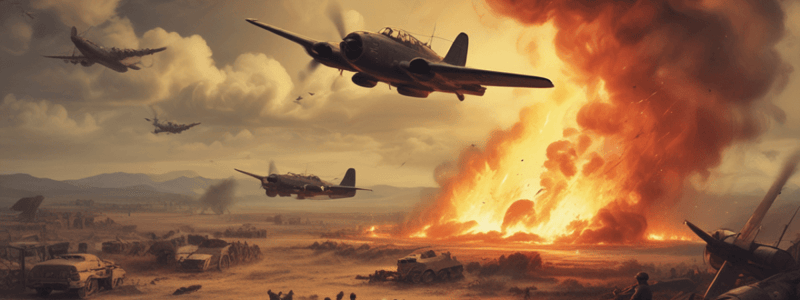Podcast
Questions and Answers
What did General Curtis LeMay do to increase the effectiveness of the U.S. air campaign against Japan?
What did General Curtis LeMay do to increase the effectiveness of the U.S. air campaign against Japan?
- Shifted from high-altitude precision bombing to low altitude firebombing (correct)
- Focused on psychological warfare operations
- Initiated a naval blockade around Japan
- Surrendered to Japanese forces
Which Japanese cities were targeted by the 21st Bomber Command in devastating firebombing raids?
Which Japanese cities were targeted by the 21st Bomber Command in devastating firebombing raids?
- Kobe, Sapporo, Fukuoka
- Nagasaki, Hiroshima, Osaka
- Tokyo, Yokohama, Kyoto
- Nagoya, Tokyo, Yokohama (correct)
What was the main objective of the U.S. strategic bombing campaign against the Japanese mainland?
What was the main objective of the U.S. strategic bombing campaign against the Japanese mainland?
- To support the Japanese war effort
- To establish permanent U.S. military bases in Japan
- To provoke a Japanese naval attack
- To break the Japanese military-industrial complex (correct)
Compared to the atomic bombings of Hiroshima and Nagasaki, what is true about the cumulative impact of the firebombing raids on Tokyo?
Compared to the atomic bombings of Hiroshima and Nagasaki, what is true about the cumulative impact of the firebombing raids on Tokyo?
What was the reason for shifting to low altitude firebombing in the U.S. air campaign against Japan?
What was the reason for shifting to low altitude firebombing in the U.S. air campaign against Japan?
Flashcards are hidden until you start studying
Study Notes
- In 1945, the U.S. air campaign against the Japanese mainland played a crucial role in forcing Japan's surrender in World War II.
- The strategic bombing against Japan began in mid-1944 as part of the Marianas campaign, aimed at destroying military industrial targets to weaken Japanese morale and support the planned invasion of the Japanese mainland.
- General Curtis LeMay, commander of the 21st Bomber Command, shifted from high-altitude precision bombing to low altitude firebombing to increase effectiveness.
- The 21st Bomber Command conducted devastating firebombing raids on Japanese cities like Nagoya, Tokyo, and Yokohama in May 1945, resulting in significant destruction, casualties, and homelessness.
- While the atomic bombings of Hiroshima and Nagasaki were more singularly destructive, the cumulative impact of the firebombing raids on Tokyo was far more devastating, destroying a considerable urban area in Japan.
Studying That Suits You
Use AI to generate personalized quizzes and flashcards to suit your learning preferences.





